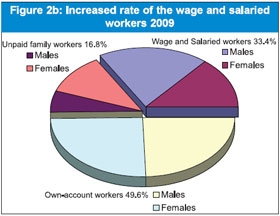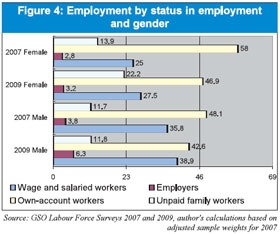
Labour market pressured despite economic growth (17/02)
17/02/2011 - 65 Lượt xem
The first Vietnam Employment Trends (VET) report last year tracked the dramatic development of Vietnam’s economy through the dynamic decade between 1997 and 2007. The latest report takes us from 2007 until 2009, bringing us through the critical years of global financial instability. For Vietnam there was relatively strong economic growth despite instability. However, the crisis did have an effect on the working population, the report reveals how.
Increases in economic development and the forces of globalisation, such as financial crises, are not in the daily considerations of most working people. Men and women all around the globe feel economic change through its impact on their working lives.
 The VET 2010 report is a vital method to help understand the way that globalisation and economic growth affects the working population here. Labour market information and analysis is critical in helping policy makers and businesspeople ensure that social and economic advancement occurs in tandem.
The VET 2010 report is a vital method to help understand the way that globalisation and economic growth affects the working population here. Labour market information and analysis is critical in helping policy makers and businesspeople ensure that social and economic advancement occurs in tandem.
The report itself is part of the ILO Decent Work Country Programme, an integral part of the One UN Plan 2006-2010. Among others, the Vietnamese government, employers and workers have asked the ILO Vietnam to focus strategically on key labour market development issues, and are working together with its development partner European Union, to do this.
The latest VET findings
The VET 2010 report highlights a number of important findings that are vital for anyone wanting to understand a fuller picture of Vietnam’s vibrant growth and economic development.
 |
Participation in the labour force increased noticeably between 2007 and 2009. This reflects the reality that in economically challenging times anywhere around the world participation in the labour market is for many people the only way to support themselves and their families.
 |
 |
Moreover, strong population growth over the last decades has put added pressure on the Vietnamese labour market. With the population increasing across all age groups, many people are added to the country’s labour force every year.
Rural to urban migration is also having an effect on labour force participation. Vietnam’s workers are primarily based in rural areas. However, the urban population is growing with consistent migration from the countryside. Research shows that the quantity of the urban population of working age increased by about 1.8 million between 2007 and 2009 and will undoubtedly continue on an upward curve.
Vietnam’s labour force nationwide increased by 2.4 million between 2007 and 2009 to a total of 49.3 million people. The labour force participation rate, defined as the ratio of the labour force to the working-age population (aged 15 years and above), also increased by 2.1 per cent. Labour force participation is projected to continue to increase by 1.7 to 2.4 per cent in the long term.
Young people are also feeling the effects of the financial crisis. Figure 1 highlights the increasing labour force participation rates among young people aged between 15 and 19 years from 37.1 per cent in 2007 to over 43.8 per cent in 2009.
Increasing labour force participation rates for young men and women indicate another important trend. Increases in participation in the labour force by young people suggest that increasing numbers of teenagers are leaving the educational system. Since early school-leaving is often linked with other markers indicating socio-economic disadvantage, such as low-income jobs or high unemployment, the analysis suggest that young people need support and incentives to stay in school.
Research shows that Vietnam’s employment-to-population ratio in 2009 was relatively high, almost 75 per cent for the population aged 15 and above.
Participation in the labour force nationwide stands at 76.5 per cent in 2009. This is a comparatively high rate worldwide, with the global labour force participation rate in 2009 at 65.1 per cent. Labour force participation rates give an indication of the quantity of labour supply in the economy and are used as an important planning instrument in the design of human resource development policies in general, and employment and training policies in particular.
The report reveals an increase in the proportion of wage and salaried workers, rising from 30.5 per cent in 2007 to 33.4 per cent in 2009. The share of vulnerable employment for women stands currently at 69.1 per cent, a telling 14.7 per cent higher than the share for men. This disparity stems from the considerable movement of women workers back to family work, which increased 8.2 per cent compared to two years before. Altogether this suggests a situation where those jobs that are newly created tend to go to men rather than women.
The proportion of vulnerable employment is down. Analyses of labour force survey data in the VET report reveal that the share of vulnerable employment decreased by 4.3 per cent between 2007 and 2009. This was primarily caused by an increased rate of wage and salaried employment (2.9 per cent) and a decreasing rate of own-account work (8.2 per cent). However, challenges still remain to address an opposite trend in unpaid family work, which increased by 4 per cent during this same period. See Figure 3.
The use of contracts in Vietnam remains patchy, with 44.7 per cent of all wage and salaried employees in 2009 working with verbal contract arrangements or without any form of contract. Between 2007 and 2009 there was a slight growth in the proportion of workers with fixed-term contracts, however this seemed to be closely related to a decrease in the amount of workers with permanent contracts.
|
Rie Vejs-Kjeldgaard, director of ILO Country Office for Vietnam
Vietnam faces many of the same risks that other countries face around the world, but in particular low productivity employment and time-related underemployment are crucial challenges. The large numbers of people that are informally employed is one of the most pressing issues. For social progress and economic growth to produce equitable and sustainable development for all workers, it must be anchored in an effective and an inclusive labour market. Therefore we must have relevant, timely, accurate, accessible, reliable and comprehensive data on the labour market. This is why the Ministry of Labour, Invalids and Social Affairs’ National Centre for Labour Market Forecast and Information is so important. |
The predominance of informal work in Vietnam is still a major challenge, but the formalising of these jobs also presents an incredible opportunity for policymakers to broaden the reach of social protection. By making sure that work in Vietnam is being carried out in the formal sector economic stability is promoted, and social protection could be offered.
Analysis of the labour force survey data shows that informal employment continued to increase with the size of the informal sector. As a share of total employment, the informal economy accounts for a slowly increasing proportion, rising slightly from 23.4 per cent in 2007 to 23.9 per cent in 2009.
 |
 |
Closer analysis reveals that unpaid family workers, and informally employed workers without social security, make up an overwhelming proportion of the workers in the formal sector. In 2009, a significant 70.5 per cent of workers in the non-agricultural formal sector were informally employed.
Young people in the labour market face specific and additional challenges. The research indicates that youth, between the ages of 15 and 24, are unable to secure their first-choice career. Young people tend to be engaged in their second-choice employment type. This indicates clearly that either job opportunities are not available at the levels of education that they have already attained, or that they lack the necessary work experience when compared to adult workers.
Sector studies in the report also highlight some important patterns. The sectors focusing on industry generated the highest GDP figures in 2009 (a share of 42 per cent of all sectors) experienced zero average annual increase in labour productivity between 2007 and 2009. ‘Labour productivity’ is an indicator for assessing the likelihood that an economy will create and sustain decent jobs with reasonable wages and salaries. However, the future projections aim for labour productivity to increase considerably, a 5 per cent is planned for the period 2011-2015 and a further 6 per cent increase between 2015 and 2020.
Challenges remain as female workers face more difficulties than their male counterparts. A review of key labour market indicators for the years 2007 and 2009 highlights persisting gender imbalances in Vietnam’s labour market. These figures, displayed in Figure 4, show the distribution of women by economic sector and status groups. The imbalances paint a picture where women’s productive potential seems to still be distinctly underutilised, a key opportunity for the future.
Formalisation, education and more good quality jobs
The core issue for Vietnam’s society and businesses is that the huge, evolving labour market is being put under pressure in a number of key areas. The overarching concern right now that is revealed in the report is that not enough higher quality jobs are being created to meet the demand of those entering the labour market. These challenges mirror the global situation. Fortunately the analysis revealed in the latest VET report also shines a light on a number of strategic opportunities.
The most obvious opportunity for Vietnam’s labour market remains in the formalisation of the informal economy. The formal sector needs to be sustained, and helped to grow, in order to generate decent work for the years to come.
A central issue for Vietnam’s future is sector changes and diversification. For the moment, the largest sectors of employment in Vietnam remains agriculture, forestry and fisheries. These sectors employed nearly 23 million people in 2008. Projections estimate that this figure is likely to decline to a projected level of 21.1 million by 2020, as the Vietnamese economy shifts towards higher value-added and more technology- and capital-intensive industries and service sectors.
Most importantly, as Vietnam’s economy evolves, a laser-sharp focus on education and skills training will be imperative. Education and training meeting future demand for skills, and support and incentives for students to remain in the education system, are critical to ensure sustained growth for Vietnam. As Vietnam’s economy diversifies into higher value-added industries, better-qualified and more highly-skilled workers will be needed to fuel this shift, and Vietnam’s future as a dynamic middle income economy.
The views expressed by the author do not necessarily represent those of VIR.
Source: VIR





 The recovery of economic growth has not brought about a comparable recovery in employment. Many economies around the world are simply not generating sufficient employment opportunities to absorb growth in the working-age population and it is equally clear that in many economies the on-going economic recovery is not yet leading to a sufficient expansion in employment opportunities. Young people in particular have been strongly affected by the crisis.
The recovery of economic growth has not brought about a comparable recovery in employment. Many economies around the world are simply not generating sufficient employment opportunities to absorb growth in the working-age population and it is equally clear that in many economies the on-going economic recovery is not yet leading to a sufficient expansion in employment opportunities. Young people in particular have been strongly affected by the crisis.






